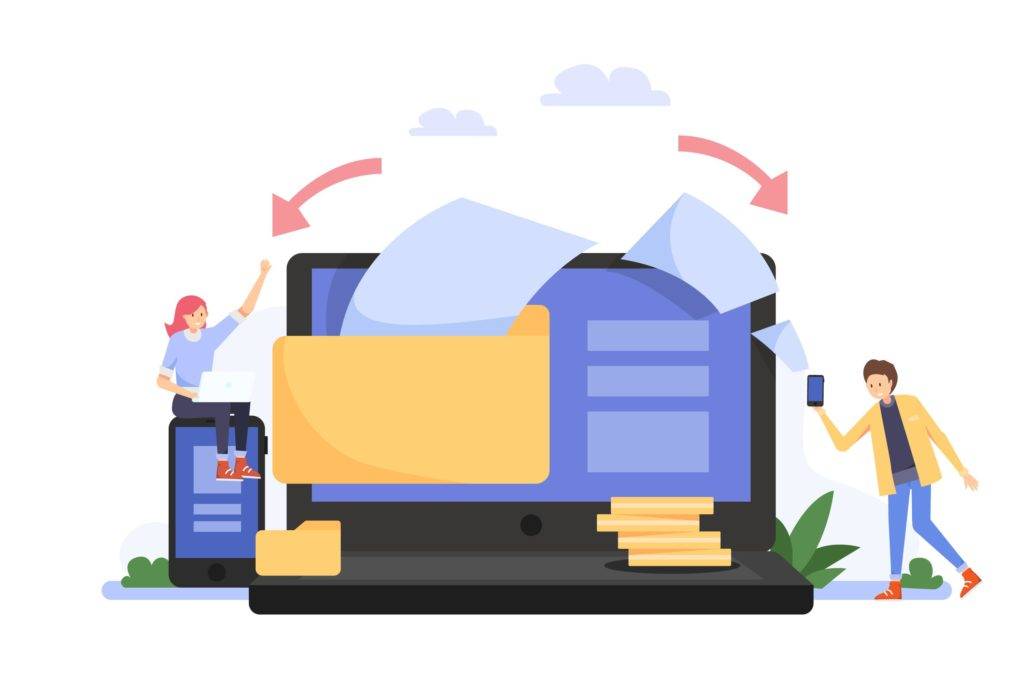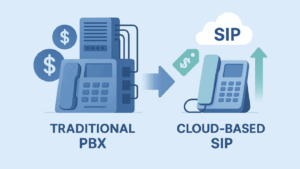
What Are Call Data Records (CDRs) and How Can They Help Your Business?
As technology advances, so does the opportunity for businesses to modernize their communications infrastructure. Session initiation protocol (SIP) trunking is one such upgrade. It allows services like chat, voice, or video calls across the internet via consolidated branches or channels that serve as virtual phone lines. It provides a host of benefits to the company, including advanced data collection methods for storing and accessing each call data record.
Referred to as call detail records, or call logs, this documentation is a valuable source of data. The information recorded can be used in a variety of ways, from tracking usage to monitoring performance and even detecting fraud. This and many other valuable productivity-enhancing and cost-saving advantages are made possible by SIP. Cloud SIP trunking consolidates communications between branches, locations, or departments without carrier fees or additional hardware while providing critical facts about each call.
What Is a Call Data Record?
A call data record (CDR) is a digital file that contains details about each call made on a telephony system. Each record includes basic facts like the source, destination, and time of the call, along with more technical details of what occurred during calls or data sessions. They provide valuable visibility into your corporate telephony usage. These records are essential tools that also give diagnostic insight into features used, capacity, performance, call patterns, reasons for call termination, and much more.
Call Data Records are one of the many streams that fuel big data analytics. Many may think of CDRs as part of their billing documentation. While that is one use, CDRs also provide a host of other data for forecasting, trending, planning, accounting, and research. Formal phone bills are a source where CDRs can be found, providing comprehensive reporting features related to calls made through a hosted VoIP service. Since you can access CDRs in near real-time, they can serve a variety of purposes where the most up-to-date results are important, such as in customer complaints, fraud, or misuse.
Related: What is IP Telephony and SIP?
Because there are a wealth of almost instantaneous data points, call records are a useful tool for tracking marketing campaigns. It gives you the ability to make quick adjustments and view the results as they occur, so you don’t waste time or money on ineffective tactics. CDRs are also valuable for promotional, cross-selling, or upselling opportunities, as well as operational functions like tracking sales.
To give a little more insight into the business use cases, we’ve detailed some examples below.
Analytics. The data gathered on caller preferences, behavior, and pain points can be analyzed to drive sales and improve customer experience.
Billing. Businesses can have better control over their budgets by forecasting billing based on how many lines they currently use.
Identification. Increase your service efficacy by identifying patterns and anomalies on your network, such as high numbers of calls coming from the same country.
Management. Call Data Records are useful for assisting with call center management by reviewing call volume, duration, and more.
Monitoring. By monitoring CDRs for the number of in and outbound phone calls, duration, and more, business managers can determine if their employees are successfully meeting their objectives.
Tracking. Tracking campaign success is made easy when a unique identifier is assigned to each, letting you know which ones generate more calls—which translates to more customers.
Typically, a CDR includes:
The originating and terminating phone numbers involved in a call
The start time and end time of the call
The duration of the call
The type of call (e.g., voice, SMS, data)
The result of the call (e.g., completed, busy, no answer)
What Information Is Included in a Call Detail Record?
A Call Detail Record (CDR) is a treasure trove of information about each phone call made through your phone system. These detail records provide a comprehensive snapshot of the call, capturing essential data points that can be invaluable for various business applications.
Typically, a CDR includes:
Caller ID and Phone Number: Identifies the origin of the call.
Called ID and Phone Number: Indicates the destination of the call.
Date and Time of the Call: Records when the call was made.
Call Duration: Measures how long the call lasted.
Call Type: Specifies whether the call was incoming or outgoing.
Call Status: Notes if the call was answered, missed, or declined.
Call Routing Information: Details like trunk group and circuit ID.
Call Quality Metrics: Includes data on jitter, packet loss, and Mean Opinion Score (MOS).
Call Termination Cause: Explains why the call ended, such as normal completion, busy signal, or no answer.
In addition to these core elements, some CDRs may also capture:
Call Recording Metadata: Information about any recordings, including start time and duration.
Call Transcription Metadata: Details about transcriptions, such as the text and confidence level.
Call Analytics Metadata: Insights into call sentiment and topics discussed.
These data records are not just for billing; they provide a wealth of information that can be used to optimize your business operations.
Benefits of Call Data Records
Call Data Records (CDRs) offer a multitude of benefits that can significantly enhance your business operations. Here are some key advantages:
Improved Billing and Cost Management: CDRs enable precise tracking and billing for phone usage, minimizing errors and disputes. This accuracy helps in better budget management and cost control.
Enhanced Customer Service: By analyzing CDRs, businesses can gain insights into customer behavior and preferences. This information allows for more personalized and effective customer service.
Increased Productivity: CDRs help in optimizing phone systems and workflows, reducing downtime and improving overall employee productivity.
Better Decision-Making: The data-driven insights from CDRs enable businesses to make informed decisions regarding their phone systems, services, and strategic initiatives.
Improved Security and Compliance: CDRs play a crucial role in detecting and preventing security threats such as toll fraud and phishing attacks, ensuring your business remains secure and compliant with regulations.
By leveraging the detailed information provided by call data records, businesses can enhance their operational efficiency and customer satisfaction.
Non-Business Uses of Call Data Records
Accessing call data records can be as simple as downloading a .csv file and can assist in multiple business scenarios. They are also useful in many non-business cases. The files can be consolidated into larger CDR streams that may be shared with third parties, such as urban planners or companies responsible for city infrastructure.
Interestingly, CDRs have long been used by law enforcement to track illegal activity or investigate crimes. In at least one instance, a call data record analysis was partially responsible for capturing a murderer. Other innovative non-business use cases include:
After the 2010 earthquake in Haiti, call data records were used to aid the relief efforts.
CDRs monitored public response to health advisories in Mexico during the 2009 swine flu epidemic.
These records helped map malaria outbreaks in Kenya and ebola outbreaks in Liberia.
In New Zealand, CDRs assisted officials in tracking the population movements post-earthquake.
Researchers in France’s Côte d’Ivoire used CDR datasets from telecommunications company Orange to study traffic issues in the region, to improve travel times.
The same set of metadata was then used to determine poverty levels across 11 regions of France, simplifying and expediting what used to be a largely manual process. This kind of work has been found useful in other countries as well.
How Is the Call Data Record Recorded?
From the time you make or receive a call, software and hardware work together to collect the metadata. The process starts with a radio signal that goes out to the closest cell towers or base stations. These stations are grouped into location areas that have a unique identifier to help the base station controller route calls to mobile phones as they change location. All calls are transmitted through a mobile switching center (MSC).
MSCs are workhorses. They perform a variety of functions from routing calls, texts, conference calls, and faxes to call handovers and connecting to the public switched telephone network. The MSC is one of the critical components of the network management subsystem.
Your call data record will not record each of these steps. Instead, the data will first be sent through a mediation layer. There, it is converted into a format that can be transmitted to OSS applications and billing systems where it is then turned into a CDR. Any information not necessary for these records is deleted.
What Is the Difference Between a Call Data Record and a SIP Record?
The primary difference between the two is when the record is created. While the CDR is produced after the call ends, the SIP record is created when the call begins. CDRs are transferred to other systems for use in various business cases like billing and reporting. Telecom components on the network use SIP records to initiate the calls.
Related: SIP Trunking Providers – What’s the Difference Between Them?
Much of the data between the two records are similar, such as the number calling and called, the billing number, start time, originator, and call type. CDRs will include some details that SIP records do not, such as duration, if it was answered, and if route out was used. SIP records will record the diversion header, P-source device, user agent, SHAKEN token, SHAKEN certificate link, and the IP address of the audio.
In summary, SIP records are an important tool for telecom networks. However, the call data record is the most beneficial for a majority of use cases.
Call Data Record Analysis and Reporting
Analyzing and reporting on Call Data Records (CDRs) is a powerful way to extract valuable insights and trends from your phone system data. This process involves collecting, processing, and analyzing CDR data to uncover patterns and optimize performance.
CDR analysis can help you:
Identify Usage Patterns and Trends: Understand how your phone system is being used and identify peak usage times.
Optimize Phone System Performance and Capacity: Ensure your phone system is running efficiently and can handle the required call volume.
Improve Customer Service and Experience: Use insights from CDRs to enhance the quality of customer interactions.
Detect and Prevent Security Threats: Identify unusual patterns that may indicate security issues, such as toll fraud.
Enhance Billing and Cost Management: Generate accurate billing reports and manage costs effectively.
CDR reporting typically includes:
Call Volume and Duration Reports: Summarize the number and length of calls.
Call Type and Status Reports: Break down calls by type (incoming or outgoing) and status (answered, missed, or declined).
Call Quality and Performance Reports: Assess the quality of calls based on metrics like jitter and packet loss.
Call Routing and Termination Reports: Detail how calls are routed and why they were terminated.
Call Analytics and Sentiment Reports: Provide insights into the content and sentiment of calls.
These reports are invaluable for making data-driven decisions and optimizing your phone system’s performance.
Common Use Cases for Call Data Records
Call Data Records (CDRs) are versatile tools that can be applied across various industries to enhance operations and achieve specific goals. Here are some common use cases:
Telecom and Communications: CDRs are essential for managing phone systems, optimizing network performance, and detecting security threats.
Customer Service and Support: Businesses use CDRs to analyze customer behavior, improve service quality, and enhance the overall customer experience.
Sales and Marketing: CDRs help track sales calls, analyze customer interactions, and refine sales strategies to boost effectiveness.
Healthcare: In the healthcare sector, CDRs are used to manage patient communications, track medical records, and improve patient care.
Finance and Banking: Financial institutions leverage CDRs to detect and prevent financial crimes, such as toll fraud and phishing attacks.
These use cases highlight the broad applicability and value of call data records in various industries, demonstrating their importance in optimizing operations and achieving business objectives.
Call Data Records and More: Features to Look For

All SIP providers are not equal. There are valuable features you can get with the right SIP partner that aren’t available with traditional phone systems. Call data records are a big one that can be useful in a wide variety of ways. But what other features should you look for in a quality SIP partner?
A Robust Control Panel. Easily manage your account, modify services or billing preferences, and access your call data records.
Dialer and Telemarketing Traffic. A full-service SIP provider allows you to accommodate dialer or telemarketing traffic without surcharges.
Large Database of DID Numbers. Ensure your provider has a large choice of US and international numbers available to search and provision instantly.
Bring-Your-Own-Bandwidth. If you are an established business or have an existing relationship with a broadband internet provider, you should be able to keep that provider when you choose your SIP partner.
International Toll Fraud Protection. A quality SIP partner should be proactive in monitoring international traffic for fraud, shutting off unauthorized calls in progress, and shutting off international calling on your trunk if necessary.
Simple Pricing. You should have options to pay monthly or annually for each unlimited SIP trunk channel with no setup fee or contract.
Nomadic e911. Your numbers can call 911 from anywhere in the U.S. and the associated address will be displayed to the EMS operator.
Fast Integrations. Look for the option to integrate with any open-source telephony application and assistance in configuring the trunks for service in minutes.
Tier-1 Redundant Network. Ensure your partner uses only Tier-1 upstream providers to route your traffic for the best voice quality, performance, and reliability.
Fault-Tolerant DID Routing. Failover in the case of a problem with the primary PBX is vital. Your partner should provide forwarding to a backup PSTN in case of failure.
Free Trial. Look for a no-obligation free trial from your prospective SIP partner so that you can see how easy it is to get started and ensure the partner is a good fit for your needs.
Leverage the Power of SIP Trunking With the Right SIP Partner
SIP.US works with your existing internet connection and SIP-compliant devices to provide superior service for your business. Provisioning is immediate and includes a free trial that allows you to make up to 60 minutes of calls. Let’s get started so you can leverage SIP trunking today.



